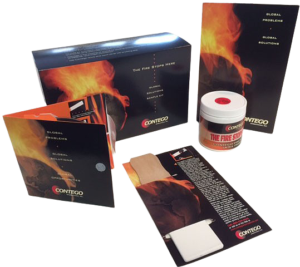Better Buildings = Healthier Workplace
Are you in line with the global initiative to build and maintain a better, safer environment? Air Quality in the work environment – hospitals, schools, offices, commercial and residential buildings – is a big area of concern.

Clumpy, toxic cementatious coating
The WELL Standard* states “Pollutants generated indoors can lead to a variety of symptoms and health conditions. Volatile organic compounds (VOCs), combustion byproducts and airborne particulate matter are known to trigger nausea, headaches, asthma, respiratory irritation and allergies. While ambient outdoor air is often better quality, natural ventilation methods, operable doors and windows, and general building envelope infiltration can diminish indoor air quality if external air quality parameters are poor.”
READ THE MSDS of the Products being used on your project. When considering required fire protection, old technology such as Spray Fire Resistant Materials (SFRM) may not meet all or any of these acceptable conditions:
- Formaldehyde levels less than 27 ppb.
- Total volatile organic compounds less than 500 μg/m³.
- Carbon monoxide less than 9 ppm.
- PM₂.₅ less than 15 μg/m³.
- PM₁₀ less than 50 μg/m³.
- Ozone less than 51 ppb.
- 0Radon less than 0.148 Bq/L [4 pCi/L] in the lowest occupied level of the project.
- Carbon monoxide levels less than 35 ppm.
- PM₂.₅ less than 35 μg/m³.
- Nitrogen dioxide less than 100 ppb.
- Formaldehyde less than 81 ppb.
A recent report from Mount Sinai Irving J. Selikoff Center for Occupational & Environmental Medicine Work Safely with Spray-on Fireproofing states:
Those who burn, prepare, grind, sift or sell [gypsum] are, as I have often observed, afflicted with great difficulty breathing…
-Bernardino Ramazzini
Big changes in intumescent technology made “green” fire retardant paint possible. Contego intumescent changes fireproofing from the LEED nightmare associated with most fire protection products to a valuable LEED points generator.
You might know the history; environmentally friendly fireproofing was an oxymoron. Most fire retardant paint formulas were toxic, carcinogenic, and laced with high concentrations of VOCs. Those products are poisonous in the can and on the surface. This translates to very toxic in burn conditions.
HAZARDS IDENTIFICATION
Caution!
Causes eye irritation
Causes skin irritation
Causes severe respiratory tract irritation
May cause risk of lung disease (i.e. silicosis and/or lung cancer)

Clean latex-based, non toxic intumescent coating
Do we really want to use this obsolete technology in our hospitals, schools, commercial & residential buildings?
Pressure treated fire resistant lumber (PTFR) is among the worst. According to USDA studies, the PTFR process is destructive to the lignins in the wood and would dissolve attachments, like screws and nails, unless they are stainless steel.
Then there are cellulosic and cementatious fireproofing materials. We’ve all seen them; they look like oatmeal when applied. The litigation list concerning these materials is lengthy and focused primarily on the constant deposition of tiny fibrils that get into the breathable air and are then inhaled straight into the lungs. Complaints in the majority of lawsuits have been centered on mesothelioma and other forms of cancer involving the respiratory system. In addition, when reading the MSDS of most intumescent coatings, the section on health risks contain clear warnings of both acute and chronic brain damage and damage to the central nervous system. Not exactly environmentally friendly.
The reason for these unhealthy toxic problems is simple. The components that make various fireproofing technologies work— whether cellulosic spray-on materials, cementatious products, mastics or intumescents—are inherently unhealthy.
This was one of the big drivers when Contego began designing cutting edge solutions for the green market niche. The challenge was to find alternatives that performed as well or, in most cases, better than what was already out there, without the risks from the past formulations. This research led to our current formulation of ZERO VOCs (ASTM D4017) and ZERO TOXINS (BSS 7239-88).
Contego meets all the Benchmarks for LEED certification, Living Building Challenge, WELL Standard and Google Red List Material Standard.
GREEN isn’t the only advantage of Contego Fire Barrier Intumescent Latex. It applies at a fraction of the thickness (and weight) needed for a latex intumescent in the past. It’s finish is as smooth as paper, pure white in color and is formulated to accept any topcoat.
That’s why we at Contego say…”White is the new Green”. Air Quality in SFRM fireproofing materials are a PROBLEM, Contego’s IFRM fireproofing is the SOLUTION! Get more information here.
*The WELL Building Standard is administered by the International WELL Building Institute™ (IWBI™), a public benefit corporation whose mission is to improve human health and well-being through the built environment.


